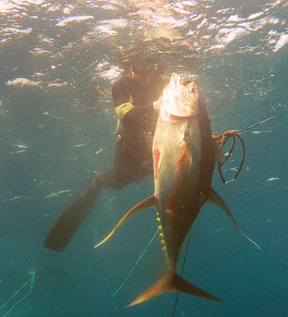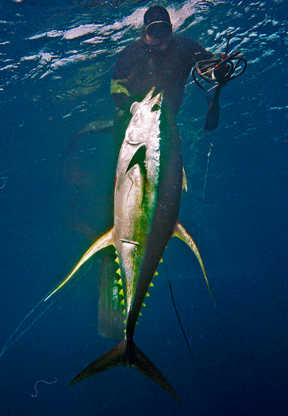
|
 |
Copyright © 2005 Terry Maas, BlueWater Freedivers
SOUTH AFRICAN LEGEND OPENS THE TUNA GROUNDS

Tommy Botha with a nice yellowfin
(enlarge)
South African divers have discovered blue water hunting for tuna. By US standards,
access to offshore waters is problematic. Since harbors are scarce, most boats are
launched on the beach and must tackle rough surf, and high seas off the Cape are common.
It took legendary S.A. spearo Tommy Botha to open up the offshore tuna grounds. Tommy
recalls his first yellowfin encounter just two years ago.
"The sun was just rising over the mountains as we left in my 6,5m rubber duck
on a 25 mile trip out to the tunny grounds. Three of us were going out to try and shoot
our first yellowfin. We had normal twin rubber carbon guns with breakaway 7mm spears.
Attached to the spear line was a 30m stretch cord with a body board. About an hour later
we heard some talk on the radio that there were a lot of birds diving on some bait fish.
We headed in that direction and found the birds diving. One of the guys pointed and said,
‘Look at the dolphins!’ The "dolphins" turned out to be thousands of
yellowfin working bait fish. Three divers in street clothes broke records getting
dressed. I won and jumped in next to the shoal.
A wall of tunny swam past me. Aiming at the head of a large fish, I was surprised
to see my spear enter just in front of the tail. All hell broke loose and unfortunately, I
lost the fish. Nearby one of my buddies, Jacques speared one and was hanging onto
his board as it churned away out to sea. I jumped on the boat, raced over and helped
retrieve Jacques’ fish. I shot the spine of the next fish, not big, but at least I a
fish of 40kgs. Jacques’ fish was over 60 kgs. We chased the fish shoal for the rest
of the morning, losing and missing, but eventually we did manage to land two more. Sure,
we learned valuable lessons but we had our first Yellowfins. Since then I have seen my
body board disappear into the deep, never to be seen again."

(enlarge)
I was fortunate to meet Tommy in 1983. Just the year before, my team placed second in
the world spearfishing championships in Chili—the highest that the US team has
scored. I dove with the Ernst brothers, Bill and John. John’s individual second place
was considered first by all international divers because he nearly overcame the
overwhelming home-team advantage built into this particular contest.
The team from South Africa was notably absent since at the last minute
its members had been "uninvited" from the contest after they had traveled to
Chili and had invested weeks of scouting effort. The team’s misfortune turned out to
be our good fortune because the South Africans, with lots of unspent funds, offered a
reward to the top placing English-speaking team. The reward was a 6-week, country-wide
tour of the country with a series of competitions with the national team of S.A.

(enlarge)
The tough-as-nails S.A. team won our immediate and lasting respect. Team member Attie
Louw presented at our first inter-country competition sporting livid white shark teeth
scars, which you could trace from kneecap to kneecap through his groin. Just 6 months
before this meet, Attie had been thrust completely out of the water in the jaws of a great
white. Andre Hartman, who entertained us with his stories of 10 great white encounters and
"that great big black eye," is now internationally known for his un-caged
freediving with GWs and for petting them from the bow of his boat.
The third member Tommy Botha is South Africa’s best-known freediver. For many
years, Tommy scoured the rugged S.A. coast for shipwrecks and silver and gold doubloons.
Much of the work was carried out in rough surf while freediving. When he wasn’t
traveling, Tommy conditioned his barrel chest by playing underwater hockey.
I witnessed one of Tommy’s feats during our second inter-country competition at
Plettenberg Bay. Our seasoned team knew all the tricks so when we saw the forecast for
strong tides, we prepared for the currents by hiding anchor blocks on the offshore reefs.
We planned to tie off our buoys to the anchors, which would allow us to rest between dives
while remaining over prime reef structure 70-feet below. While hanging onto one such buoy,
I was surprised to see Tommy swimming next to me holding his own against the stiff
current. Unbelievably, he made continual dives in these conditions and routinely bested my
bottom time by a half-minute—he never rested. Since then, Tommy has dominated S.A.
spearfishing championships, overall winning the national title 11times. Looking for new
challenges, Tommy writes:

(enlarge)
"I have been fortunate to dive on just about every atoll and reef in the Indian
Ocean, while searching for sunken treasure on shipwrecks. It has taken me to remote
places where no one has speared fish. I have seen different and exotic fish, but
being in the water with a wall of yellowfin and being able to spear them has been a
completely different experience. Swimming in relatively clean, warm water, seeing
these big fish swimming around, is an unreal experience. You are afraid of doing something
wrong that will scare the fish and make them disappear. You must not miss your shot
and you must be very careful to not entangle yourself. Even just being on the boat,
surrounded by yellowfin, is a memorable experience."
For Tommy, a typical trip starts with evaluation of the weather the night before. If
the offshore buoys indicate the wind is not too strong, he will phone for the daily tuna
report to find out how many fish were caught and their location. Tommy says,
"As you know hake guts are probably the best bait for tunny and luckily, there are
always some tunny fisherman and hake long liners in the area. We talk to the fishermen on
the long liners who call us when the yellowfin follow them. It takes the fishermen a
couple of hours to pull up their lines and to clean their fish at sea. That is when
the action starts."
Tommy travels to the CPS position where the fish were spotted on the previous day.
There he puts some lines in the water and starts trawling. As soon as he catches
albacore (there are plenty of them) or yellowfin, he throws in a bit of chum—chopped
sardines. It doesn’t take much time for the fish to move into the chum line.
Other times, Tommy approaches the slow moving long liners who point out the yellowfin when
they see them. Seventy to 90 kg tuna follow the long liners, routinely surrounding
the boat. The water temperature is normally 18-20 C (66-98 F). When it is
colder than 18 C, it is harder to find fish. The visibility is 10-to 30-m.
The fish are very close to the surface and many fish are speared from the surface.
Sharks are not a problem. Tommy recalls, "I have seen one small mako (now
deceased) and a couple of blue sharks." The typical season starts in October and runs
to June. October and November are good. In December and January, the water
temperature is too warm and the fish are very hard to find. From February to the
middle of June, with more settled weather, the fishing is very good.
Wind is the only problem with the smaller boats. The bigger boats do not really have
a problem with the wind. If the wind is too strong, you drift away from the boat too
quickly. Tommy says, "It is very difficult to say how many days are lost to
weather, but we have a 90% success rate in getting fish once we go. Also, for people
who want to shoot albacore tunny, they will find many fish between 10-to 30-kg,—as
much as you can shoot. Staying in guest houses in Cape Town is not expensive. Small
groups can be accommodated by friends."
Many top divers manufacture much of their own gear so it is natural that Tommy
developed his own bluewater gun. Tommy remembers:
"I was lying next to the boat waiting for yellowfin to swim closer. Gavin
, with his longer-range wooden gun was next to me waiting for the same fish. The
fish were well out of my range when Gavin shot the spine off with his 4-band wood gun. At
that moment, I decided that I had to have a gun like that. After doing some
research on the internet and asking you for advice (thank you), a friend and I started
building laminated teak guns and developed our own trigger parts. The gun was an
instant success. I have speared over 30 tunny with my first gun. We also make
a foam board with a cleat (to lock the shock cord). We have refined the gun and
board and have developed four different guns. The biggest gun is a 5 band gun, with
a 10mm spear. I want to stress the importance of the foam board. It is
essential for landing the fish quickly. I use a 25m length of 10mm shock cord and have
never had a failure. The biggest fish that has been landed with our guns and board
is a 180kg Black Marlin."
If you want some really impressive yellowfin action, Tommy and his crew
will guide you. This is a great winter get-away with a chance to dive with one of the
world’s best spearfishermen. Tommy can be reached by email: lebotha@iafrica.com

(enlarge)
|




